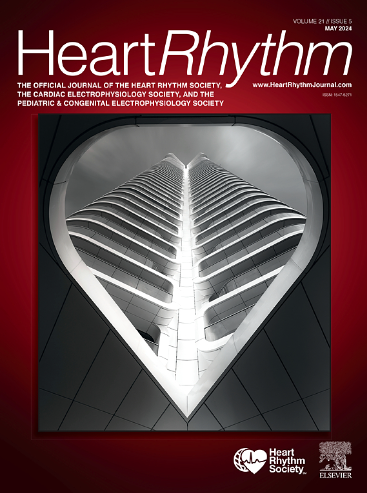法洛氏四联症的慢传导解剖峡部:预防性 "VT消融的机会。
IF 5.7
2区 医学
Q1 CARDIAC & CARDIOVASCULAR SYSTEMS
引用次数: 0
摘要
背景:经修复的法洛氏四联症(rTOF)患者面临室性心动过速(VT)和心脏性猝死(SCD)的风险。大多数室性心动过速源于由右室切口、室间隔缺损补片、三尖瓣和肺动脉瓣连接的 5 个缓慢传导峡部(SCAI;传导速度≤ 0.5 m/s)。从历史上看,风险分层电生理学研究(EPS)涉及程序性心室刺激(PVS),通过 VT 诱导引导 ICD 植入和/或 VT 消融:评估一种 "预防性 "消融策略,即在没有诱发 VT 的情况下消融 SCAI,以减少 ICD 植入和心律失常事件,并将其与 "历史性 "策略进行比较:这是一项单中心、回顾性队列研究。方法:这是一项单中心回顾性队列研究。"历史队列 "接受了 PVS,以指导 ICD 植入和/或 VT 消融。预防性队列 "接受了右心室电解剖图绘制和 SCAI 消融术。对两组患者的心律失常死亡、心脏骤停、持续 VT 和 ICD 并发症的复合终点进行了比较:93名rTOF患者进行了风险分层EPS。在 57 名预防性患者中,33 人(58%)发现/消融了 SCAI,16 人(28%)在消融前有诱发 VT,1 人接受了 ICD。在 35 名历史患者中,15 人(43%)有诱发 VT:3 人在 PVR 期间进行了冷冻消融,11 人接受了 ICD。中位 21 个月(IQR 8,35)内没有预防性患者达到复合终点,而中位 125 个月(IQR 90,142;P= 0.017)内有 10 例(29%)历史患者达到复合终点。无消融相关并发症:结论:预防性 SCAI 消融可减少 ICD 植入数量,降低心律失常事件的发生率,且无消融相关并发症。本文章由计算机程序翻译,如有差异,请以英文原文为准。
Slowly conducting anatomic isthmuses of tetralogy of Fallot: An opportunity for “prophylactic” ventricular tachycardia ablation
Background
Patients with repaired tetralogy of Fallot are at risk of ventricular tachycardia (VT) and sudden cardiac death. Most VTs arise from 5 slowly conducting anatomic isthmuses (SCAIs; conduction velocity ≤0.5 m/s) bound by the right ventriculotomy, ventricular septal defect patch, and tricuspid and pulmonic valves. Historically, risk stratification electrophysiologic studies involved programmed ventricular stimulation with VT induction guiding implantable cardioverter-defibrillator (ICD) implantation or VT ablation.
Objective
This study aimed to evaluate a “prophylactic” strategy of ablating SCAIs even in the absence of inducible VT to reduce ICD implantation and arrhythmic events and to compare this with the “historical” strategy.
Methods
This was a single-center, retrospective cohort study. The historical cohort underwent programmed ventricular stimulation to guide ICD implantation or VT ablation. The prophylactic cohort underwent right ventricular electroanatomic mapping and ablation of SCAIs. A composite end point of arrhythmic death, cardiac arrest, sustained VT, and ICD complication was compared between the cohorts.
Results
Ninety-two patients with repaired tetralogy of Fallot had risk stratification electrophysiologic studies. Of 57 prophylactic patients, SCAIs were identified or ablated in 33 (58%), 16 (28%) had inducible VT before ablation, and 1 received ICD. Of 35 historical patients, 15 (43%) had inducible VT; 3 had cryoablation during pulmonic valve replacement and 11 received ICDs. No prophylactic patients met the composite end point during a median 21 months (interquartile range, 8–35 months) vs 10 (29%) historical patients during a median 125 months (interquartile range, 90–142 months; P = .017). There were no ablation-related complications.
Conclusion
Prophylactic SCAI ablation is associated with fewer ICD implantations and a reduction in incident arrhythmic events without ablation-related complications.
求助全文
通过发布文献求助,成功后即可免费获取论文全文。
去求助
来源期刊

Heart rhythm
医学-心血管系统
CiteScore
10.50
自引率
5.50%
发文量
1465
审稿时长
24 days
期刊介绍:
HeartRhythm, the official Journal of the Heart Rhythm Society and the Cardiac Electrophysiology Society, is a unique journal for fundamental discovery and clinical applicability.
HeartRhythm integrates the entire cardiac electrophysiology (EP) community from basic and clinical academic researchers, private practitioners, engineers, allied professionals, industry, and trainees, all of whom are vital and interdependent members of our EP community.
The Heart Rhythm Society is the international leader in science, education, and advocacy for cardiac arrhythmia professionals and patients, and the primary information resource on heart rhythm disorders. Its mission is to improve the care of patients by promoting research, education, and optimal health care policies and standards.
 求助内容:
求助内容: 应助结果提醒方式:
应助结果提醒方式:


